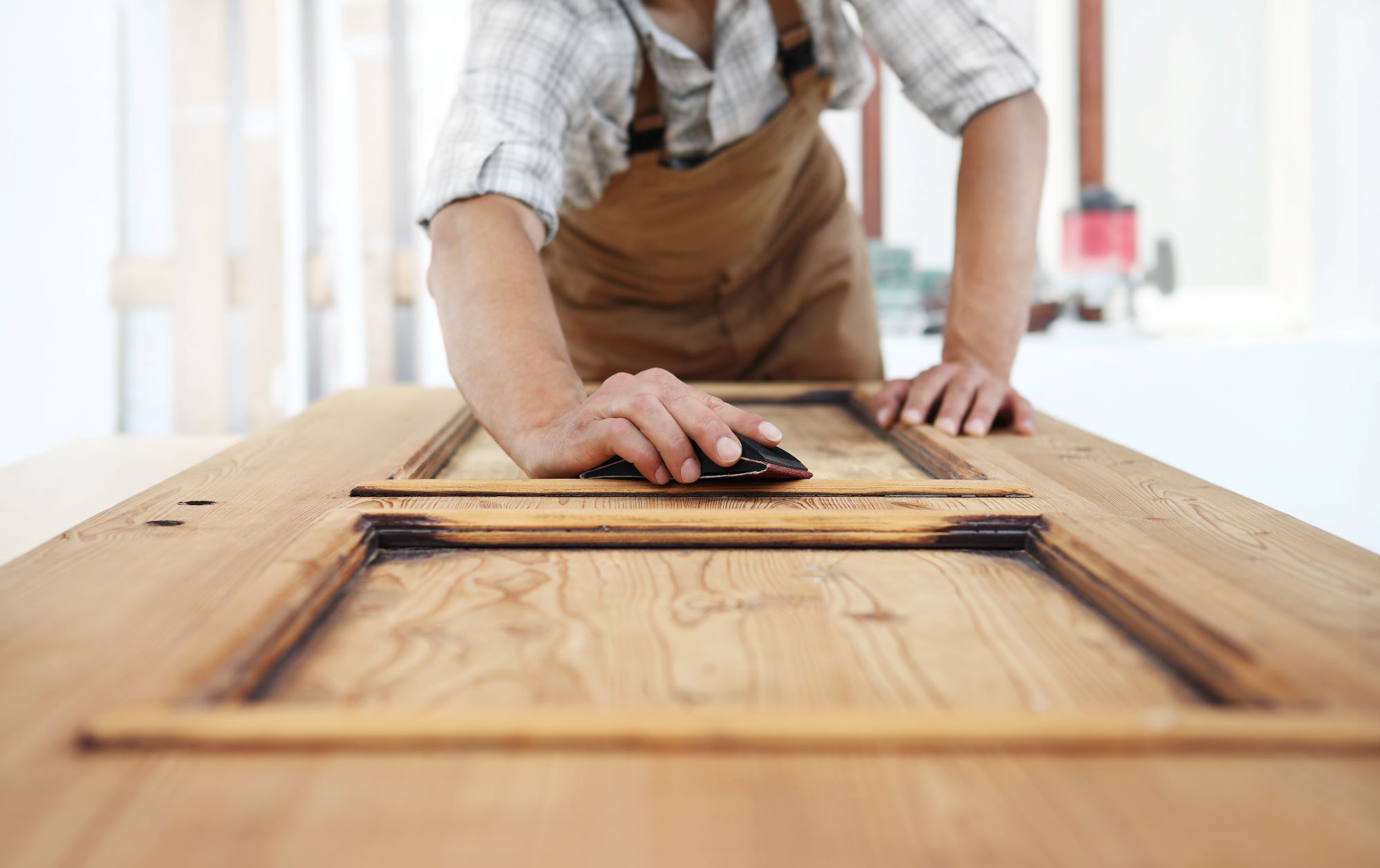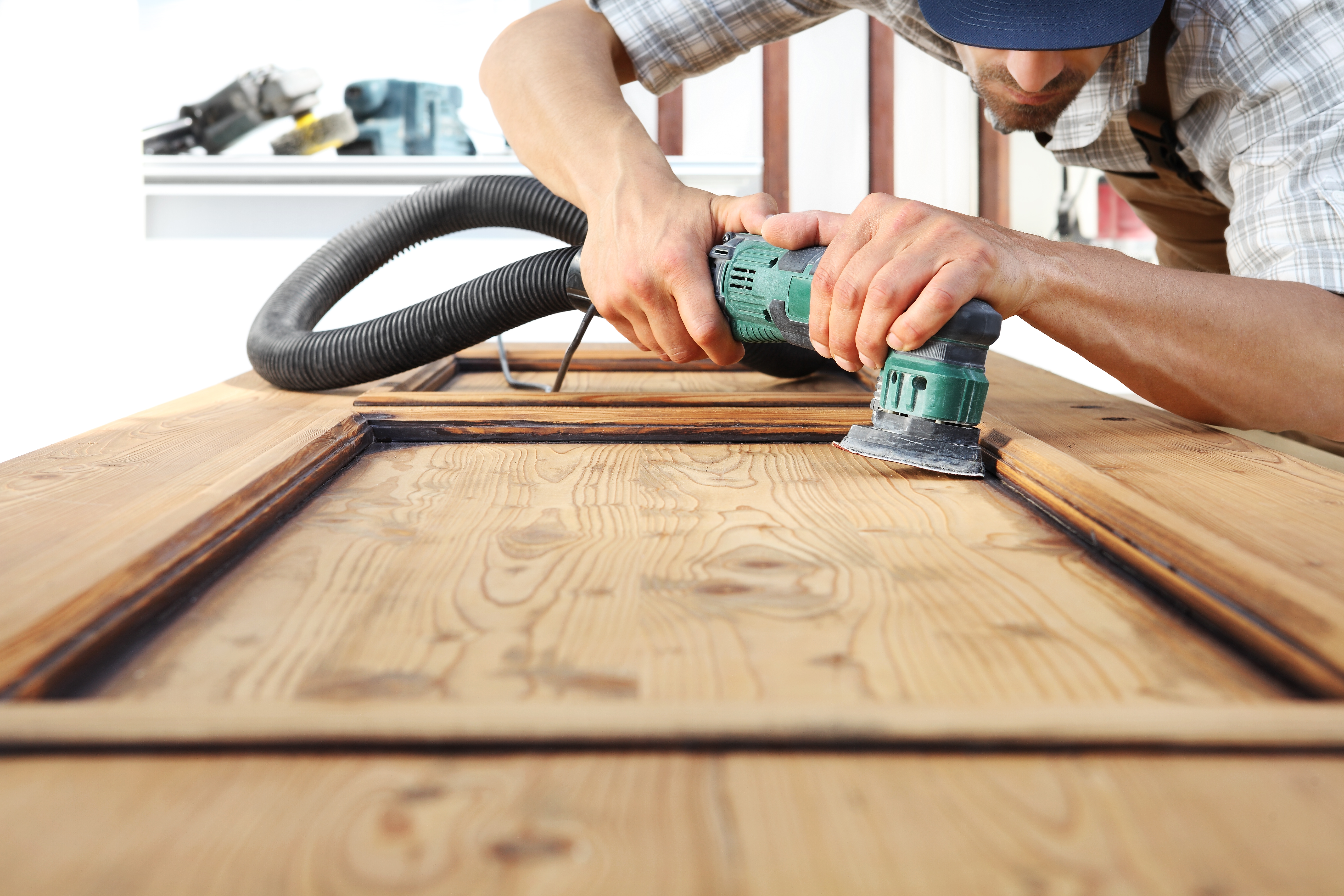Sanding doors: A smart DIY guide for a flawless finish
Want to know the best technique for sanding doors? Follow our step-by-step guide, plus discover the best tools and sandpaper grades for the job

Sanding doors probably isn’t high on anyone’s list of favourite DIY tasks, but it is a process well worth the time and effort — and done properly it makes a massive difference to the finish of your door.
As keen DIYers will know, the secret to a successful project often lies in the preparation and sanding doors is an excellent example of this. Cutting corners when sanding doors is almost guaranteed to result in an inferior end result.
Here we explain why you not only need to sand previously painted doors before repainting, but also why you need to grab that sander before you paint or varnish a bare wood door.
Sanding doors: The tools you’ll need
- Dust sheet
- Dust mask
- Eye protection
- Vacuum or dustpan and brush
- Sander and/or sanding block
- Sandpaper of various grits
- Damp cloth
- Masking tape (if leaving the hardware in place)
- Screwdriver (if removing the door and/or hardware)

Sanding doors: Five steps to a smooth finish
Follow our handy guide below and you’ll be sanding doors like a pro in no time.
1. Prepare the room
Sanding doors can create a lot of dust, so removing the door from its hinges and taking it outside to work on can be beneficial. Removing the door also means you can lay it on a flat surface.
Don’t worry if you can’t remove the door. Protect the immediate area with dust sheets and get yourself a dust mask and eye protection.
2. Prepare the door
If you are leaving the door on its hinges, you need to prop it open with a doorstop to prevent it from moving while you work.
Using a screwdriver, remove any hardware, like door handles, before you start. If this isn’t possible, protect the hardware from scratches and dust with masking tape.
Always sand with the grain of wood. Panelled doors will often have joins where the grains meet at right angles. Locate these joins before you start to avoid sanding over them in the wrong direction and scratching the wood.
3. Start with the flat areas
Before sanding, select the appropriate sandpaper(s) grade for the job; you’ll need two or three in combination to get a professional finish. Start with the most abrasive from your selection, working your way down to the least abrasive, sweeping away dust as you go. For help choosing the correct sandpaper, read my recommendations below.
The way you tackle sanding a door will depend on the shape and structure of the door. Always start with flat areas of wood. If your door has panels with intricate moulding, tackle these areas separately.
4. Tackle any detailing
After the flat areas, it’s time to sand any moulding or detailing on the door; these corners, edges, and profiles require a precise approach. Sanding sponges, like these ones available to buy from Amazon, are helpful for sanding intricate sections, or you can fold a piece of sandpaper to create a sharp edge which is ideal for getting into tight gaps.
Use the same method of working through the grades of sandpaper until you have removed all the paint or varnish and have smoothed the wood you’ve revealed.
5. Clean up
Once you have worked your way around the door, check you haven’t missed any spots. First, remove any dust with a soft brush or vacuum and wipe it over with a damp cloth. The wood should be smooth and even without visible scratches or marks and no traces of paint and varnish.
The door is ready to be primed, waxed, painted or varnished.

What grit sandpaper do I need to sand a door?
If you are using loose sheets of sandpaper, they’ll likely be graded into three categories: coarse, medium and fine. Replacement sheets or discs for electric sanders will have a more specific particle or ‘p’ value as their sandpaper grade.
When refinishing a door in poor condition with several layers of old, chipped paint, start with a coarse paper and follow up with medium then fine, or the following combination of grits works well, 60, then 100, followed by 150.
For a door with fewer layers of paint or varnish to remove, medium followed by fine will likely be sufficient. You might opt for the following combination of grits, 80, 120, and 180.
In both these examples you could start with a coarser grit if required and add a finer paper to finish if the wood isn’t coming up smooth enough. You shouldn’t skip more than one grit when choosing your combinations.
When sanding a bare wood door before painting or varnishing, medium or even fine sandpaper will usually suffice. These recommendations are just a guide as you’ll need to assess each door you sand individually.
Is it better to sand by hand or with a sander?
When it comes to sanding doors, the best option is a combination of both sanding by hand and using an electric sander. Sanding by hand can be laborious and time-consuming over a large area but it’s quieter, less messy and will give you a superior finish on the final pass.
An electric sander is excellent for making light work of the flat parts of the door, but it might not be the best option for tight corners, edges or intricate detailing, so it makes sense to mix it up and use both to get the best finish you can.
You can check out our guide to the best orbital sanders if you don't have one already or want to upgrade.

What type of sander is best for doors?
The answer depends on how many doors you are sanding and how long your DIY ‘to-do’ list is.
If you are sanding lots of doors, or are a keen DIYer, and your sander is likely to get lots of future use, it makes sense to invest in a quality random orbital sander with a dust collector. (Products such as the Matika DBO180 cordless 125mm random orbit sander get our vote.)
On the other hand, you can pick up a basic ‘mouse’ sander for about £20 that will work perfectly well for a single door or two and has the added advantage of being quite good at getting into crevices with its pointed ‘nose’ that you’d otherwise have to sand by hand.
It’s worth noting that you can often attach your domestic vacuum hose to an electric sander, which almost eliminates the issue of dust. This is great for working on projects indoors.
Can I sand uPVC doors ready for painting?
Absolutely! uPVC can be transformed by a coat of specialist paint. When sanding uPVC the aim is to ‘rough up’ the surface a little, as this creates a key to help the paint adhere. Therefore, fine (higher grit) sandpaper is ideal and you don’t need to apply a huge amount of pressure.
uPVC doors often have rounded edges, so a sanding sponge is useful as it moulds itself to the shape of the door, making the job easier. You can check out our guide on painting a uPVC door too for the perfect finish.
Get the Homebuilding & Renovating Newsletter
Bring your dream home to life with expert advice, how to guides and design inspiration. Sign up for our newsletter and get two free tickets to a Homebuilding & Renovating Show near you.
Claire is a DIY and home interiors writer and content creator who specialises in budget room transformations, creative DIY projects and resourceful home styling. Passionate about interiors and DIY and with over 15 years of home improvement experience under her (tool) belt, Claire runs the popular home interiors blog ClaireDouglasStyling.co.uk .
Always up for a challenge, Claire enjoys learning new skills and shares all her DIY tips, tricks and behind-the-scenes styling insights with followers on her Instagram and Tiktok accounts (both @clairedouglasstyling).
When she's not writing or DIYing, Claire enjoys foraging for flowers and foliage and experimenting with interesting materials and decorating techniques to incorporate into future interior schemes; microcement and postal tubes were a recent unusual but triumphant pairing!

